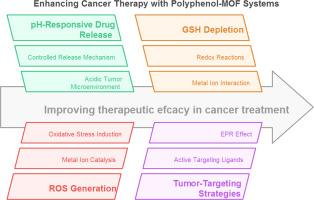Polyphenol-functionalized metal-organic frameworks: A strategic platform for advanced cancer drug delivery and synergistic therapy
IF 5.7
3区 材料科学
Q2 MATERIALS SCIENCE, MULTIDISCIPLINARY
引用次数: 0
Abstract
Polyphenol-functionalized metal-organic frameworks (MOFs) have emerged as a revolutionary paradigm in cancer therapeutics, combining the structural versatility of MOFs with the bioactive and multifunctional properties of polyphenols. This review comprehensively analyzes recent advancements in the design, synthesis, and biomedical applications of polyphenol-MOF hybrids for targeted drug delivery and synergistic cancer therapy. By leveraging polyphenols such as tannic acid, epigallocatechin gallate (EGCG), gallic acid, and polydopamine, these hybrid systems exhibit enhanced biocompatibility, pH-responsive drug release, and tumor-targeting capabilities. Key innovations include the integration of polyphenol coatings or coordination networks with MOFs (e.g., ZIF-8, MIL-100, UiO-66) to enable stimuli-triggered cargo release, reactive oxygen species (ROS) generation, and multimodal therapeutic effects (chemodynamic, photothermal, and sonodynamic therapy). Case studies highlight the role of polyphenol-MOF hybrids in overcoming limitations of conventional chemotherapy, such as poor drug solubility, off-target toxicity, and multidrug resistance. Furthermore, in vitro and in vivo evaluations demonstrate their efficacy in inducing apoptosis, depleting glutathione (GSH), and enhancing immunotherapy responses. Challenges such as scalability, long-term biosafety, and clinical translation are critically discussed, alongside future directions for engineering next-generation polyphenol-MOF nanoplatforms. This review underscores the transformative potential of polyphenol-MOF hybrids in precision oncology and advocates for their integration into mainstream cancer treatment strategies.

多酚功能化金属有机框架:晚期癌症药物传递和协同治疗的战略平台
多酚功能化金属有机框架(MOFs)结合了多酚的生物活性和多功能特性,已成为癌症治疗领域的革命性范例。本文综述了多酚- mof复合物在靶向给药和协同治疗癌症方面的设计、合成和生物医学应用方面的最新进展。通过利用多酚,如单宁酸、表没食子儿茶素没食子酸酯(EGCG)、没食子酸和聚多巴胺,这些杂交系统表现出增强的生物相容性、ph反应性药物释放和肿瘤靶向能力。关键的创新包括将多酚涂层或协调网络与mof(例如ZIF-8、MIL-100、UiO-66)集成,以实现刺激触发的货物释放、活性氧(ROS)的产生和多模式治疗效果(化学动力学、光热和声动力治疗)。案例研究强调了多酚- mof复合物在克服常规化疗局限性方面的作用,如药物溶解度差、脱靶毒性和多药耐药。此外,体外和体内评价表明其在诱导细胞凋亡、消耗谷胱甘肽(GSH)和增强免疫治疗反应方面的功效。讨论了可扩展性、长期生物安全性和临床转化等挑战,以及下一代多酚- mof纳米平台的未来发展方向。这篇综述强调了多酚- mof复合物在精确肿瘤学中的变革潜力,并倡导将其整合到主流癌症治疗策略中。
本文章由计算机程序翻译,如有差异,请以英文原文为准。
求助全文
约1分钟内获得全文
求助全文
来源期刊

Materials Research Bulletin
工程技术-材料科学:综合
CiteScore
9.80
自引率
5.60%
发文量
372
审稿时长
42 days
期刊介绍:
Materials Research Bulletin is an international journal reporting high-impact research on processing-structure-property relationships in functional materials and nanomaterials with interesting electronic, magnetic, optical, thermal, mechanical or catalytic properties. Papers purely on thermodynamics or theoretical calculations (e.g., density functional theory) do not fall within the scope of the journal unless they also demonstrate a clear link to physical properties. Topics covered include functional materials (e.g., dielectrics, pyroelectrics, piezoelectrics, ferroelectrics, relaxors, thermoelectrics, etc.); electrochemistry and solid-state ionics (e.g., photovoltaics, batteries, sensors, and fuel cells); nanomaterials, graphene, and nanocomposites; luminescence and photocatalysis; crystal-structure and defect-structure analysis; novel electronics; non-crystalline solids; flexible electronics; protein-material interactions; and polymeric ion-exchange membranes.
 求助内容:
求助内容: 应助结果提醒方式:
应助结果提醒方式:


